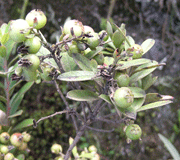James L. Luteyn and Paola Pedraza-Peñalosa
The New York Botanical Garden
|
|
Gaylussacia is a New World genus of about 50 species, centered in southeastern Brazil and southeastern North America. |
Shrubs or subshrubs. Leaves alternate, coriaceous to membranous, subimbricate or laxly-spaced, evergreen and persistent or deciduous, margin entire, glandular-crenate or subserrate, apex with a subsessile gland, pubescence simple, sometimes glandular, pinnately-nerved. Inflorescence axillary, racemose, or flowers solitary. Flowers 4-5-merous, without odor; (corolla) aestivation imbricate; calyx articulate with pedicel; hypanthium turbinate to hemispheric; lobes connivent or inflexed in fruit; corolla cylindric, urceolate, or campanulate, short-lobed, often 5-angled, white or red; stamen 10, equal, about as long as corolla; filaments distinct, shorter than anthers (rarely longer), almost always pilose and/or ciliate, lacking spurs; anthers dorsifixed above middle, lacking disintegration tissue; thecae smooth; tubules thin, dehiscing through narrowly oblong, lateral to subterminal pores; pollen lacking viscin threads; ovary pseudo-10-locular; style equalling stamen or a little longer. Fruit a drupe with 10 pyrenes, carnose, succulent, and obtusely (8-) 10-ribbed when mature.
Key to Neotropical Species Back to Top
Sorry, there is no taxonomic treatment forGaylussacia at the moment. The reader is referred to the most recent taxonomic treatment by Sleumer (1967).
